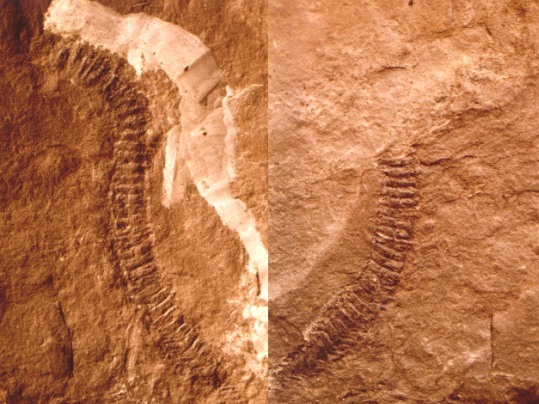

Pleurojulus steuri
Manebach (Germany)
Unter-Rotliegendes (Lower-Permian)
more photos
I have collected this 3.8 cm long millipede in the spoil heaps of the coal mines in Manebach in Thüringia (Germany). It was the first millipede that has been found there and it is now in the museum Schloss Bertholdsburg in Schleusingen. It was described in 1998 by Prof. J.W. Schneider and Dr. R.Werneburg in the article: Arthropleura und Diplopoda (Arthropoda) aus dem Unter-Rotliegend des Thüringer Waldes (Veröffentl. Naturhist. Mus. Schleusingen, Band 13: 19-36). The drawing and reconstruction in this section are from this article.
Millipedes eat decaying plants and they are not predators like the
centipedes. Often they are provided with defence glands with which they can
secrete a biting liquid. At this fossil they are still visible. Attached
to the rings of the exoskeleton are so-called pleurites, more or less triangular
projections. This is where the name Pleurojulus comes from. These
pleurites are also visible at the fossil.
Furthermore the fossils show remains of the legs, which were relatively long.
A difference between centipedes and millipedes is the one pair of legs per
body segment for centipedes whereas the millipedes have two pairs. That is
why the class of the millipedes is called Diplopoda.
Pleurojulus steuri is characterized by the pleurites which are clearly
separated from the rest of the skeleton and by the ridges on the skeleton
rings. Look at the detail photos to see them.
The millipede Pleurojulus steuri probably appeared rather often out
of the soil. Indications are the long legs, with which
he could run, and the strong defence glands.
Drawing of the complete fossil
Restoration of the environment